Dell XPS 14z: Thoroughly Reviewed
by Jarred Walton on October 24, 2011 9:00 AM ESTDecent Battery Life
Here’s one area where the ultrabook argument is really going to have a hard time gaining traction with me: battery life. It’s great that you can get an ultra thin laptop, but if getting something to 0.8” thick or less requires the sacrifice of battery capacity, a slightly larger laptop will win out. Even with a ULV processor, the ASUS UX21E can’t hope to match what other Core i5 laptops can provide. Here are the results, though bear in mind we’re comparing the 14z against a limited selection of laptops. Check out Mobile Bench if you’d like to see the full set of results.
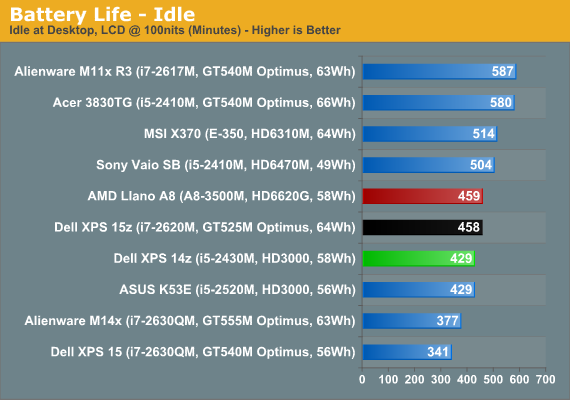
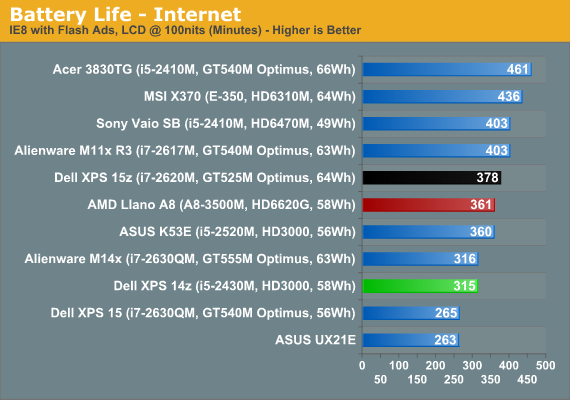
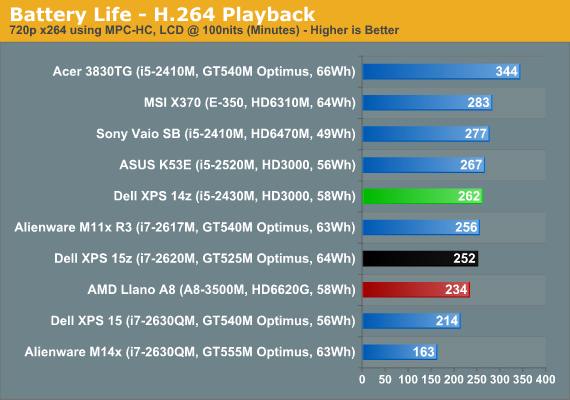
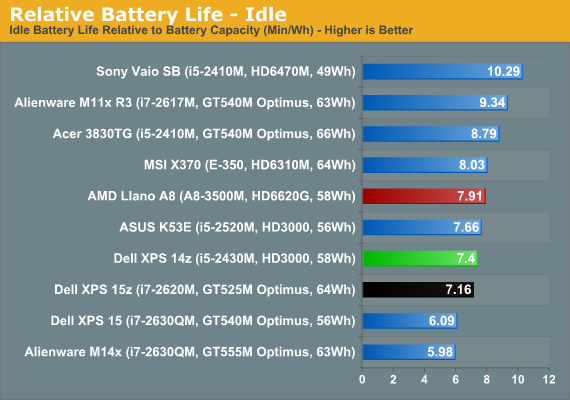
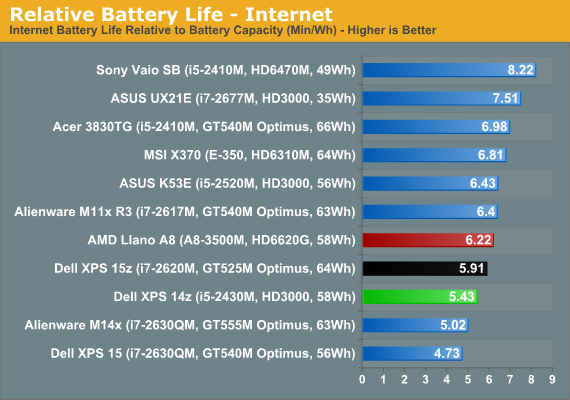
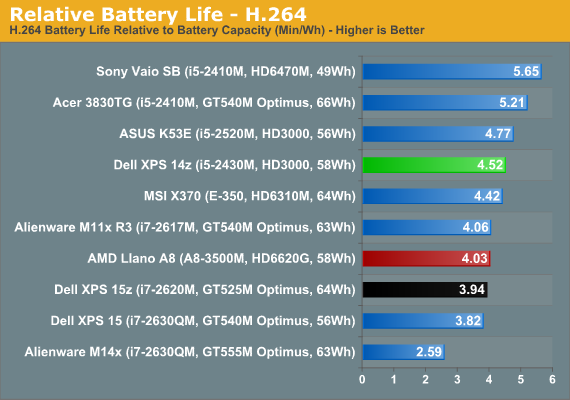
The 14z places in the middle of the pack for battery life, and only the H.264 relative battery life is slightly higher. However, if we look at a larger set of laptops we find that the 14z actually ranks roughly in the top third of battery life among laptops. In terms of raw mobility, five hours of Internet surfing and up to seven hours of idle battery life should be sufficient for most users, and four hours of H.264 playback is enough to get you through a couple of full-length movies.
Noise and Heat
The review sample we received doesn’t have the upgraded CPU or discrete graphics, which really helps to keep temperatures and noise in check. The XPS 14z appears to have three fan speeds that you’re likely to encounter: slow, medium, and high. Idle and light loads will usually run with the fan at a barely audible 31.2dB (from ~15”). Put a sustained load on the laptop for a minute or two and you’ll hear the fan spin up to a much more noticeable 38dB. After several minutes (and likely in hotter environments), the fan appears to have one more speed available that puts out 41dB.
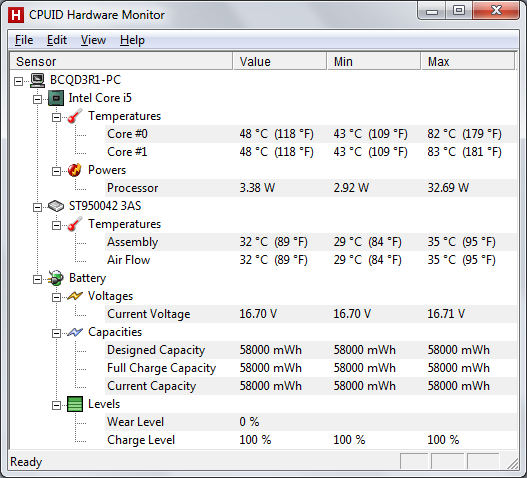
We looped 3DMark06 for several hours and were able to hit maximum fan speed, and temperatures start to get into the higher than typical range. Of note is that a similar sustained load doing H.264 encoding also hit 82C—Intel basically shares the thermal design power budget of the CPU with the IGP, so adding a 100% CPU load test while looping 3DMark didn’t increase the temperatures. With a GT 520M or the i7-2640M CPU upgrade, you’ll more likely encounter increased fan noise, and we’re a little concerned that the cooling setup may prove insufficient in some cases. Most likely the 14z will work fine even with the upgraded CPU/GPU, but there’s probably a reason Dell isn’t offering more than the entry-level GT 520M, and with the dual-core i5-2430M already hitting 83C it’s pretty clear that a 45W quad-core chip would need more cooling than the current chassis provides.










60 Comments
View All Comments
hechacker1 - Monday, October 24, 2011 - link
Apple's reputation I think is exaggerated because they take the time to factory color calibrate the screens. I don't think any other PC manufacturer does the same.But even Apple's factory calibration lately has tended toward the cooler 6800K temperatures instead of an ideal 6500K for web browsing or watching videos. They are playing into the fact that people tend to like the ultra bright, cool balanced screens that make them seen "bright and white" when comparing them side by side.
Looking at past Anandtech reviews, it's clear the Macbook's generally have very high quality screens brightness, color quality, and contrast wise.
Sure they are lacking in resolution on the laptops, but OS-X isn't resolution independent yet.
kishorshack - Monday, October 24, 2011 - link
Go for DELL XPS 15 it has an awesome screenI can look at it for ages :)
MobiusStrip - Tuesday, October 25, 2011 - link
"This is one area where I applaud Apple, they provide high quality, high-res (16:10 in some cases!) screens."Rendered garbage by Apple's insistence on shoving pathetic glossy screens down customers' throats.
Oh, you can pay $150 extra for matte on the biggest MBPs, but you can't get it on the machines most likely to leave the house: the 13" MBP or the Airs.
Glossy screens are the biggest regression in computers ever. Yet manufacturers just get a free pass on this fraud.
Stuka87 - Monday, October 24, 2011 - link
So I like the small bezel around the screen. Its about time somebody did this (if somebody else has, I apologize for not knowing). This is one of the things that I really dislike about my Precision M4600. They could have easily fit a larger 16:10 display.Its a shame the quality of the display in the 14z is so poor. The rest of it seems to be a fairly decent design.
tipoo - Monday, October 24, 2011 - link
I really wish they kept that 525M in there like the 15", the 520 is about half as fast. In fact, its not far from the HD3000.Death666Angel - Monday, October 24, 2011 - link
"I’m not sure why they include only one SS port, given the second USB port is right next to it."Not sure if this applies here, but I couldn't install Windows 7 from my USB stick on my Llano system with an AsRock A75M-ITX and A6-3500 CPU. It just didn't recognize the stick. In the USB 2.0 ports there was no problem. I guess it's driver issues. If that is the case, I can see why they want to keep at least one USB 2.0 port available.
If that is not the case and USB 3.0 makes no problems when installing from media attached to it, then disregard this post. :-)
dagamer34 - Monday, October 24, 2011 - link
Well, Windows 7 doesn't natively have USB 3.0 drivers included on the disk, so it's going to be confused by the chipset connected to that port. Should be fixed in Windows 8 though (it has native Windows 8 support).dagamer34 - Monday, October 24, 2011 - link
Ooops, I meant native USB 3.0 support.hechacker1 - Monday, October 24, 2011 - link
Isn't it backwards compatible though? The bios might have an option to run it in HiSpeed mode or whatever if it can't be detected as USB3.0 without a driver.jpochedl - Tuesday, October 25, 2011 - link
USB3.0 can run at USB2.0 speeds, but the WinPE environment still needs a driver that supports the USB3.0 chipset in order to access the USB3.0 port....